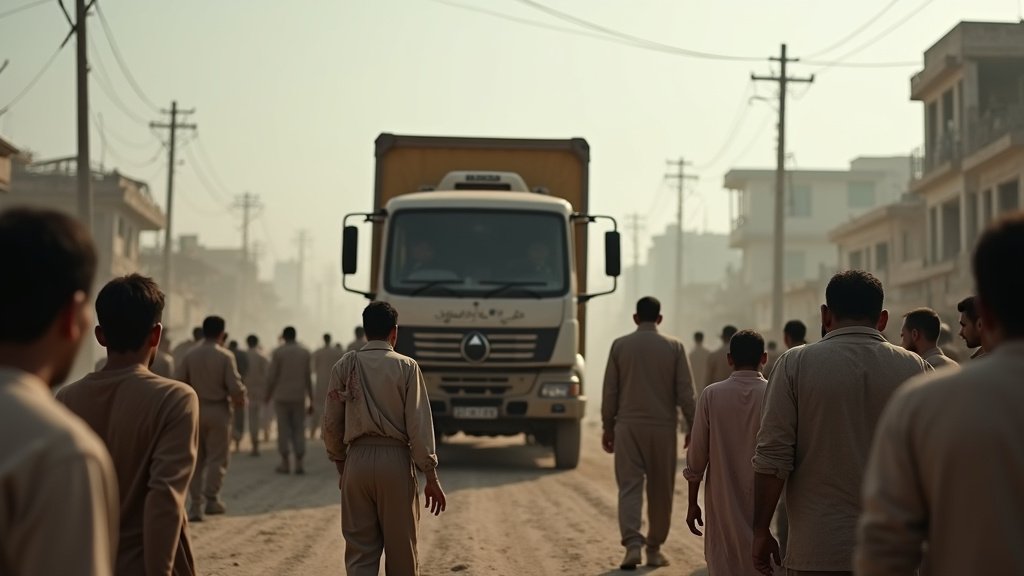GAZA CITY – A week after a fragile ceasefire took hold, the humanitarian crisis in the Gaza Strip has deepened significantly, with Palestinians facing critical shortages of food, water, and essential medical supplies. The promised surge in aid remains largely stalled due to delays in opening key crossings, particularly the Rafah border crossing with Egypt, raising international concern and prompting stark warnings from global leaders.
Despite the cessation of hostilities, intended to facilitate a massive influx of humanitarian assistance, the reality on the ground paints a grim picture. Palestinians continue to suffer a harsh daily struggle for basic necessities, exacerbated by Israel’s continued restrictions on aid flow, which contravene the spirit, if not the letter, of the truce.
Humanitarian Crisis Deepens Amid Aid Blockade
The United Nations’ World Food Programme (WFP) has confirmed it has enough food stockpiled to feed Gaza’s population for three months, but emphasizes that consistent and unimpeded access is paramount. “To keep going – and reach everyone – we need lasting access and a stable operating environment,” the WFP stated. “The ceasefire must hold. We cannot go back.”. While some aid trucks have entered Gaza, delivering an average of 560 tonnes of food daily since the ceasefire began, this amount is still considered a “drop in the ocean” by Gaza media officials and falls far short of the thousands of aid vehicles required weekly to meet the overwhelming needs.
Medical services remain severely limited, with many of Gaza’s 2.2 million residents displaced and struggling to survive amid widespread destruction. Reports indicate that as of late September 2025, nearly 42,000 people had sustained life-altering injuries, with over 5,000 requiring amputations. Essential medicines, consumables, and laboratory reagents were at critically low levels or zero-stock by the end of September. Famine conditions are already present in parts of the territory, and access to northern Gaza, where the humanitarian crisis is most acute, remains extremely challenging due to damaged infrastructure and closed crossings.
Ceasefire Fragility and Diplomatic Hurdles
The ceasefire, which went into effect around October 10, 2025, appears increasingly precarious. A significant point of contention is the delayed reopening of the Rafah crossing. While Israel has stated preparations are underway for the movement of people, it has also stressed that aid will not pass through this major gateway, insisting it was never part of the truce agreement. Instead, humanitarian supplies must undergo Israeli security inspections at the Kerem Shalom (known to Israelis as Kerem Shalom) crossing, a process that slows down delivery.
This delay is intrinsically linked to the contentious issue of returning the bodies of deceased Israeli hostages. Israel has expressed significant anger over the slow handover of these remains, accusing Hamas of failing to adhere to its commitments. Hamas, however, states that locating all bodies is difficult due to the extensive rubble from Israeli military operations. The emotional weight of these unprocessed losses in Israel is creating intense pressure on its government. One body handed over by Hamas was even found not to match any of the missing hostages, further escalating tensions.
US President’s Threat and International Pressure
Amidst these escalating tensions, United States President Donald Trump issued a strong warning to Hamas. He declared that “if Hamas continues to kill people in Gaza, which was not the Deal, we will have no choice but to go in and kill them”. While Trump later clarified that US troops would not be involved, suggesting other regional actors would act “under our auspices,” the threat signals a continued US focus on Hamas’s actions. The international community, including UN agencies, continues to call for urgent action to address the dire humanitarian situation and urges all parties to adhere to the ceasefire.
Escalating Violence in the West Bank
Meanwhile, the occupied West Bank has seen a disturbing rise in violence. Reports indicate that Israeli settlers have carried out numerous attacks against Palestinians. Between October 7 and 13, 2025, settlers were responsible for multiple assaults, leading to injuries and property damage. This trend has been escalating, with settlers frequently targeting Palestinian farmers and their land, particularly during the crucial olive harvest season. Over the first eight months of 2025, more than 1,000 settler attacks were documented in the West Bank, making it a particularly violent year.
A Precarious Path Forward
As the world watches this unfolding news, the situation in Gaza remains critically precarious. The ceasefire, while averting further immediate bloodshed, has not translated into the sustained humanitarian relief that millions desperately need. The continued delays at border crossings, the unresolved issues surrounding the return of hostages’ remains, and the ongoing violence in the West Bank all cast a long shadow over the prospects for lasting peace and stability in the region. The immediate need for consistent, large-scale humanitarian aid delivery remains paramount, lest the fragile truce crumble entirely, plunging Gaza back into a deeper abyss of suffering.

